|
COVID-19 Information
The City of Palms Bridge Club continues to monitor the Lee County Health Department website to determine our COVID 19 policies.
We ask all of our players to be vigilant and if experiencing COVID symptoms, to stay home and only return when symptoms disappear and testing negative.
Masks
Masks offer protection against all variants.
- CDC continues to recommend wearing a mask in public indoor settings in areas of substantial or high community transmission, regardless of vaccination status.
- CDC provides advice about masks for people who want to learn more about what type of mask is right for them depending on their circumstances.
- Everyone 2 years or older who is not fully vaccinated should wear a mask in indoor public places.
- In general, you do not need to wear a mask in outdoor settings.
- People who have a condition or are taking medications that weaken their immune system may not be fully protected even if they are fully vaccinated. They should continue to take all precautions recommended for unvaccinated people, including wearing a well-fitted mask, until advised otherwise by their healthcare provider.
- If you are fully vaccinated, to maximize protection and prevent possibly spreading COVID-19 to others, wear a mask indoors in public if you are in an area of substantial or high transmission.
Wearing a mask over your nose and mouth is required on planes, buses, trains, and other forms of public transportation traveling into, within, or out of the United States and while indoors at U.S. transportation hubs such as airports and train stations. Travelers are not required to wear a mask in outdoor areas of a conveyance (like on open deck areas of a ferry or the uncovered top deck of a bus).
How to Select
When selecting a mask, there are many choices. Here are some do’s and don’ts.
DO choose masks that
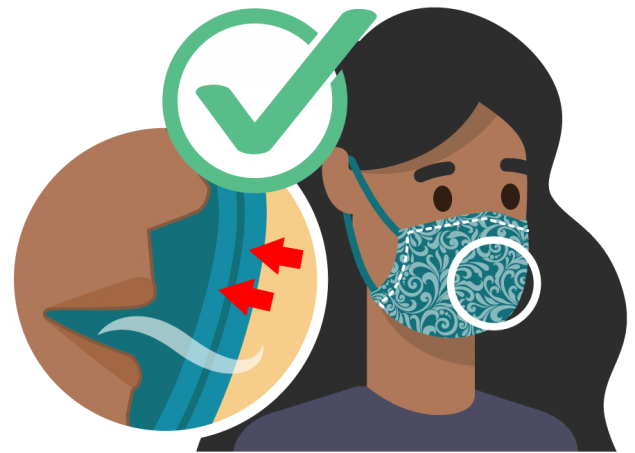
Have two or more layers of washable, breathable fabric
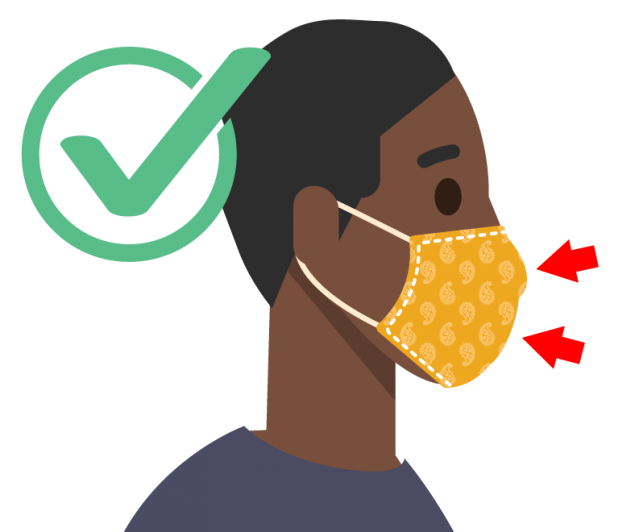
Completely cover your nose and mouth
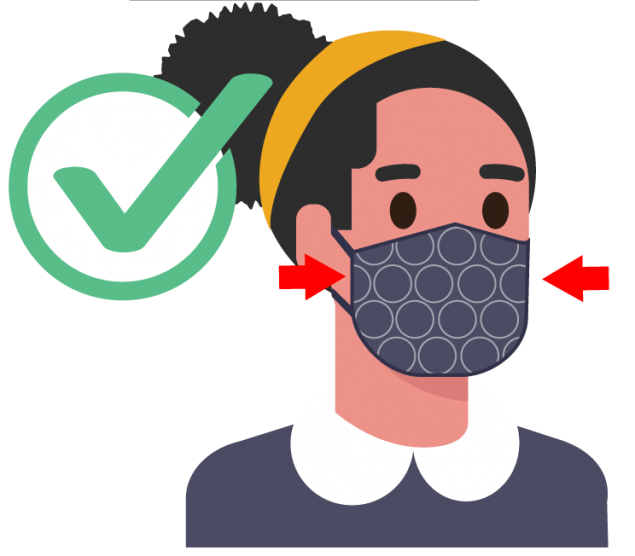
Fit snugly against the sides of your face and don’t have gaps
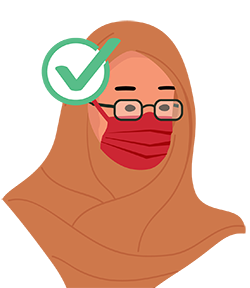
Have a nose wire to prevent air from leaking out of the top of the mask
DO NOT choose masks that
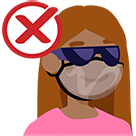
Are made of fabric that makes it hard to breathe, for example, vinyl
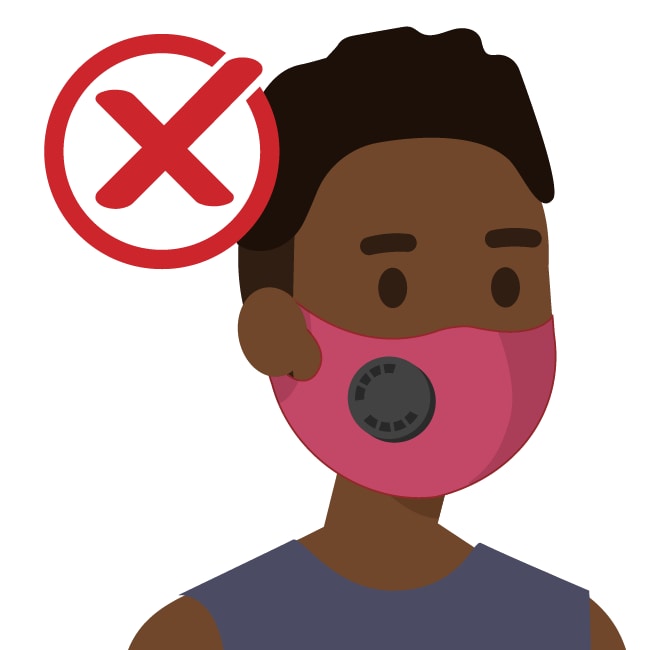
Have exhalation valves or vents which allow virus particles to escape
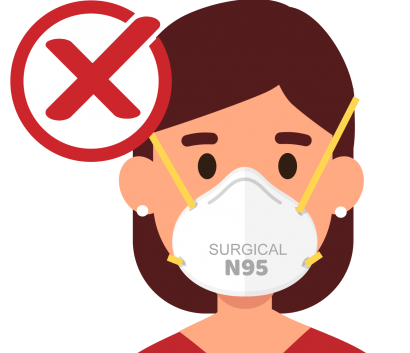
Are specially labeled “surgical” N95 respirators, as those should be prioritized for healthcare personnel
Special Considerations
Gaiters & face shields
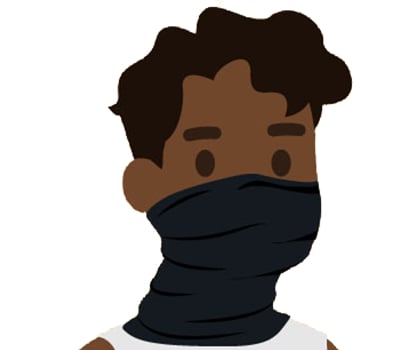
Wear a gaiter with two layers, or fold it to make two layers
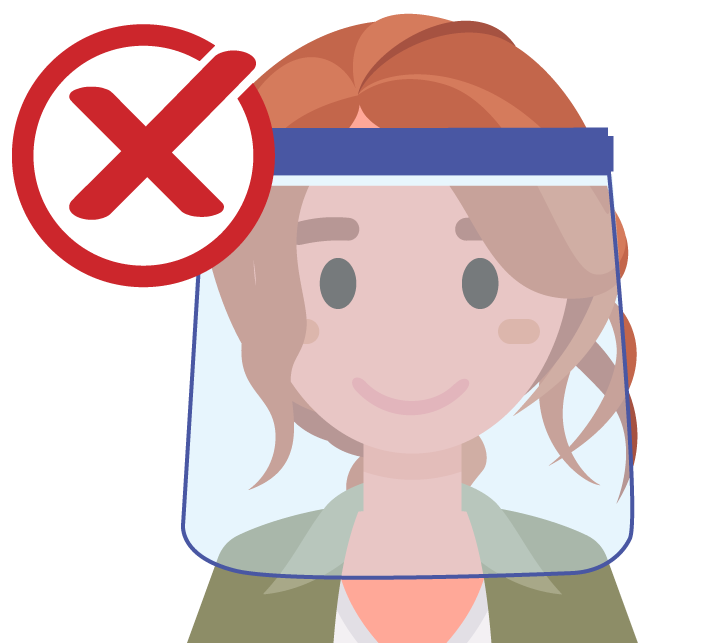
Not recommended: Evaluation of face shields is ongoing, but effectiveness is unknown at this time.
Children
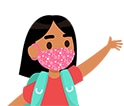
Find a mask that is made for children to help ensure proper fit
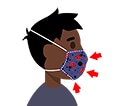
Check to be sure the mask fits snugly over the nose and mouth and under the chin and that there are no gaps around the sides
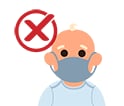
Do NOT put a mask on children younger than 2 years old
Cold weather gear
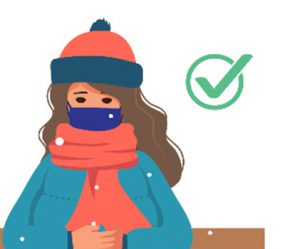
Wear your scarf, ski mask or balaclava over your mask

Scarves, ski masks and balaclavas are not substitutes for masks
People with beards
Certain types of facial hair, like beards, can make mask fitting difficult. Masks that fit well protect you better. To have a better fit, people with beards can shave their beards or trim their beards close to the face.
Other ways to improve fit
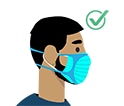
Use a mask fitter or brace.
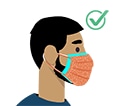
Wear one disposable mask underneath a cloth mask that has multiple layers of fabric. The second mask should push the edges of the inner mask against the face and beard.
For people with beards that are not trimmed close to the face, masks may fit loosely around the beard. However, people with beards should still wear a mask. Masks designed for people with beards are being evaluated, and information will be provided when it becomes available.
People with disabilities
Certain groups of people may find it difficult to wear a mask, including some children 2 years and older and people of any age with certain disabilities.
Appropriate and consistent use of masks may be challenging for some, including people with certain disabilities. Challenges may be caused by being sensitive to having material on the face, difficulty understanding why wearing a mask is protective (such as those with an intellectual disability), or having difficulty controlling behavior.
When determining if children and people with certain disabilities should wear a mask, assess their ability to
- Wear a mask correctly
- Avoid frequent touching of the mask and their face
- Limit sucking, drooling, or having excess saliva on the mask
- Remove the mask without assistance
For people who cannot wear or safely wear a mask because of a disability as defined by the Americans with Disabilities Act (ADA) (42 U.S.C. 12101 et seq.), consider reasonable accommodation for workers who are not fully vaccinated, who are unable to wear a mask, or who have difficulty wearing certain types of masks because of a disability.
If you are caring for children and people with certain disabilities who may need assistance with wearing masks, you should
- Ask your healthcare provider for advice to help the person you are caring for to wear a mask and ask for alternative ways of reducing transmission risk.
- Ensure proper mask size and fit.
- Remove their mask before sleeping, napping, when they may fall asleep (such as in a car seat or stroller), and in situations when continual supervision is not possible.
- Consider prioritizing wearing a mask in public settings and when around people who don’t live in your household, particularly when indoors. Masks may not be necessary when you and the person you are caring for are outside and away from others, or with other people who live in the same household. However, some localities may have mask mandates while out in public and these mandates should always be followed.
Masks should not be worn by:
- Children under 2 years
- A person with a disability who cannot wear a mask, or cannot safely wear a mask, for reasons related to the disability
- A person for whom wearing a mask would create a risk to workplace health, safety, or job duty as determined by the workplace risk assessmentexternal icon
People who are deaf or hard of hearing and those who will interact with people who are hearing impaired
If you interact with people who rely on reading lips, you may have difficulty communicating while wearing a mask.
- Consider wearing a clear mask or a cloth mask with a clear panel.
- Generally, vinyl and non-breathable materials are not recommended for masks. However, for ease of lip-reading, this is an exception to that general guidance.
- If you are not able to get a clear mask, consider using written communication, closed captioning, or decreasing background noise to make communication possible while wearing a mask that blocks lips.
People with certain underlying medical conditions
Most people with underlying medical conditions can and should wear masks.
- If you have respiratory conditions and are concerned about wearing a mask safely, discuss with your healthcare provider the benefits and potential risks of wearing a mask.
- If you have asthma, you can wear a mask. Discuss with your healthcare provider if you have any concerns about wearing a mask.
Mask use and carbon dioxide
- Wearing a mask does not raise the carbon dioxide (CO2) level in the air you breathe.
- Cloth masks and surgical masks do not provide an airtight fit across the face. The CO2 escapes into the air through the mask when you breathe out or talk. CO2 molecules are small enough to easily pass through mask material. In contrast, the respiratory droplets that carry the virus that causes COVID-19 are much larger than CO2, so they cannot pass as easily through a properly designed and properly worn mask.
How to Wear
Wear a mask correctly and consistently for the best protection.
- Be sure to wash your hands or use hand sanitizer before putting on a mask.
- Do NOT touch the mask when wearing it. If you have to touch/adjust your mask often, it doesn’t fit you properly, and you may need to find a different mask or make adjustments.
Do wear a mask that
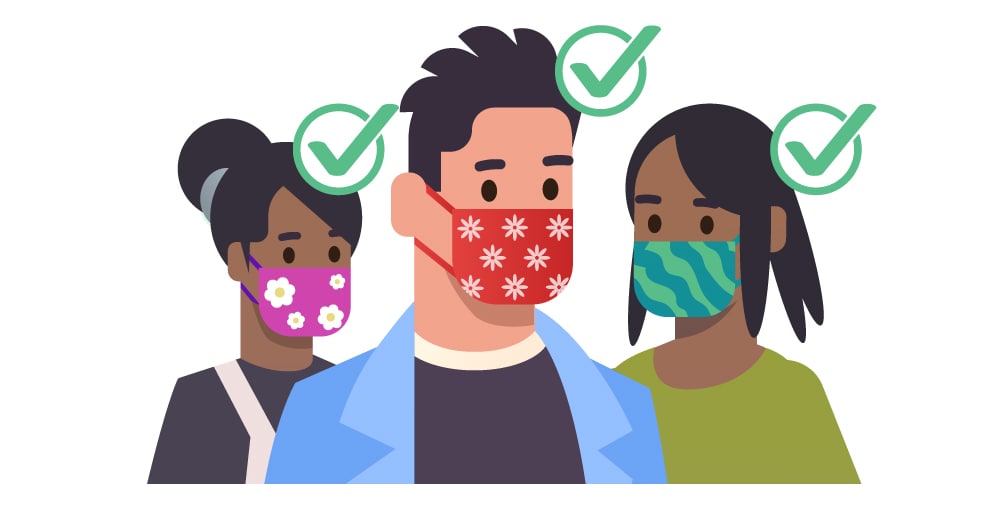
- Covers your nose and mouth and can be secured under your chin.
- Fits snugly against the sides of your face.
How NOT to Wear a Mask
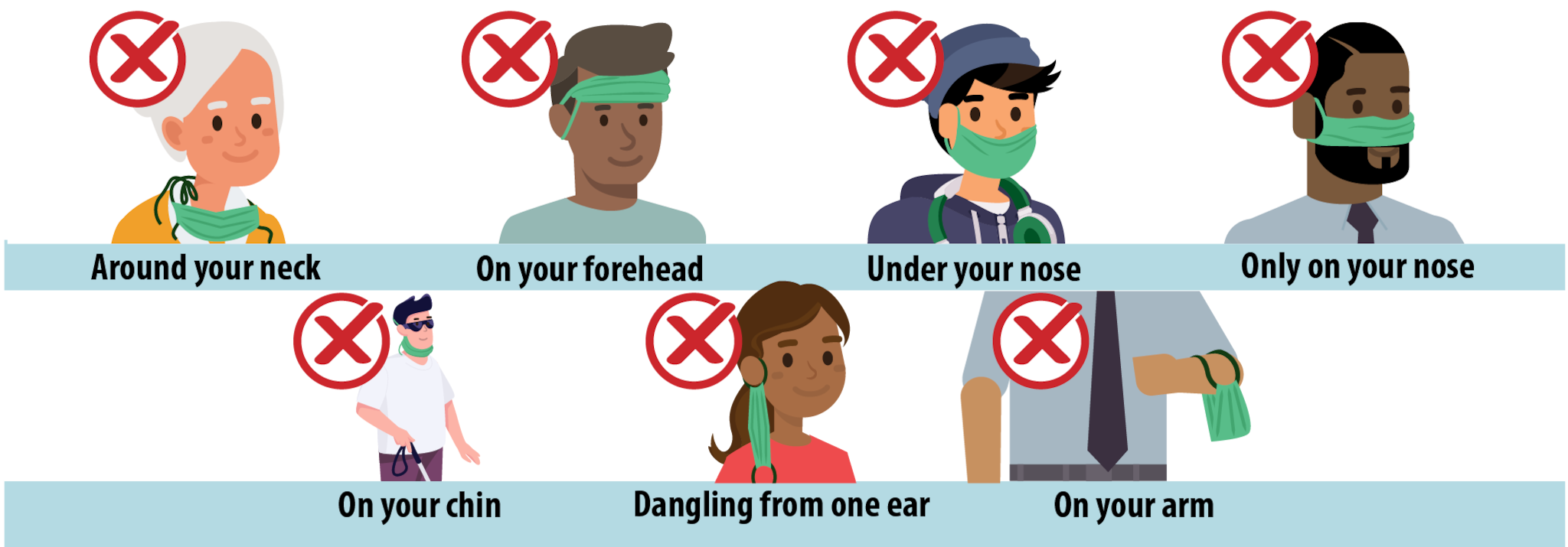
How to take off a mask
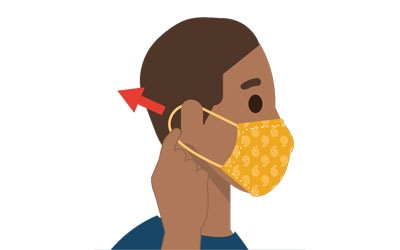
lite icon
Carefully, untie the strings behind your head or stretch the ear loops
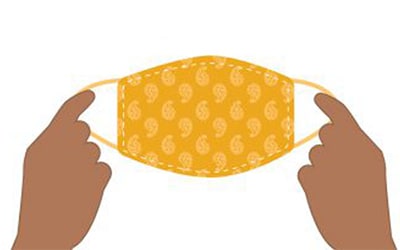
lite icon
Handle only by the ear loops or ties
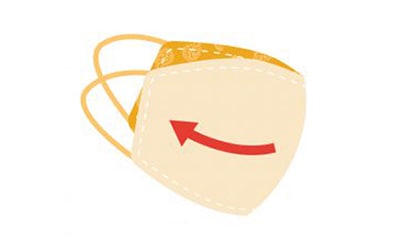
lite icon
Fold the outside corners together
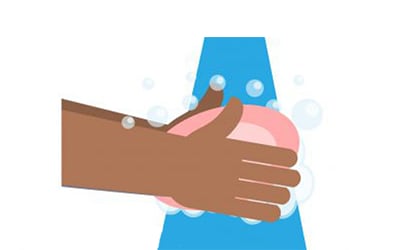
lite icon
Be careful not to touch your eyes, nose, and mouth when removing and wash hands immediately after removing
How to Clean
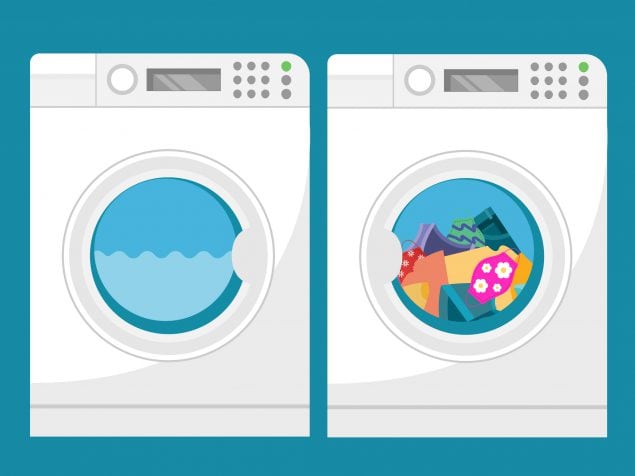
Reusable masks should be washed as soon as they become dirty, or at least once a day. If you have a disposable face mask, throw it away after wearing it once. Always and wash your hands after handling or touching a used mask.
Using a washing machine
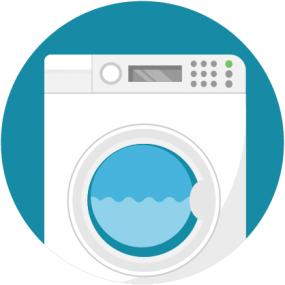
- Include your mask with your regular laundry.
- Use regular laundry detergent and the appropriate settings according to the fabric label.
By hand
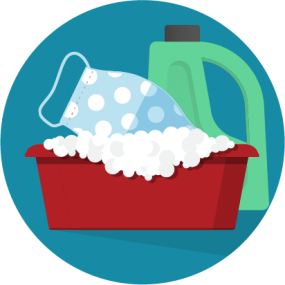
- Wash your mask with tap water and laundry detergent or soap.
- Rinse thoroughly with clean water to remove detergent or soap.
Dry Your Mask
Dryer
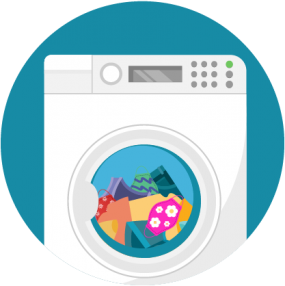
- Dry your mask completely in a warm or hot dryer
By hand

- Hang your mask in direct sunlight to dry completely. If you cannot hang it in direct sunlight, hang or lay it flat and let it dry completely.
How to Store
Store wet or dirty masks in a plastic bag
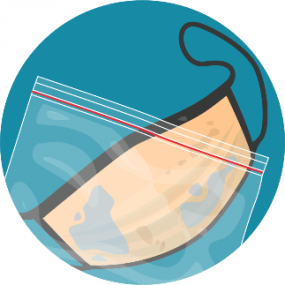
If your mask is wet or dirty from sweat, saliva, make-up, or other liquids or substances, keep it in a sealed plastic bag until you can wash it. Wash wet or dirty masks as soon as possible to prevent them from becoming moldy. Wet masks can be hard to breathe through and are less effective than dry masks.
Store masks that are not wet or dirty in a paper bag
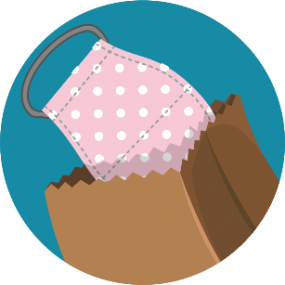
You can store your mask temporarily to reuse later. Remove your mask correctly and wash your hands after touching a used mask. Keep it in a dry, breathable bag (like a paper or mesh fabric bag) to keep it clean between uses. When reusing your mask, keep the same side facing out.
If you are taking off your mask to eat or drink outside of your home, you can place it somewhere safe to keep it clean, such as your pocket, purse, or paper bag. Make sure to wash or sanitize your hands after removing your mask. After eating, put the mask back on with the same side facing out. Be sure to wash or sanitize your hands again after putting your mask back on.
Additional Resources
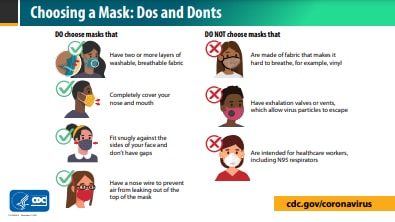
Choosing a Mask: Dos and Donts
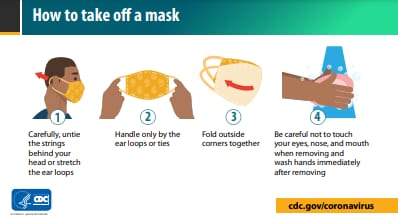
How to Take Off a Mask
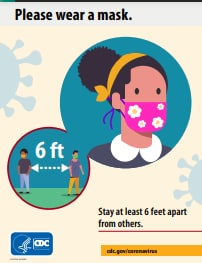
Please Wear a Mask
|